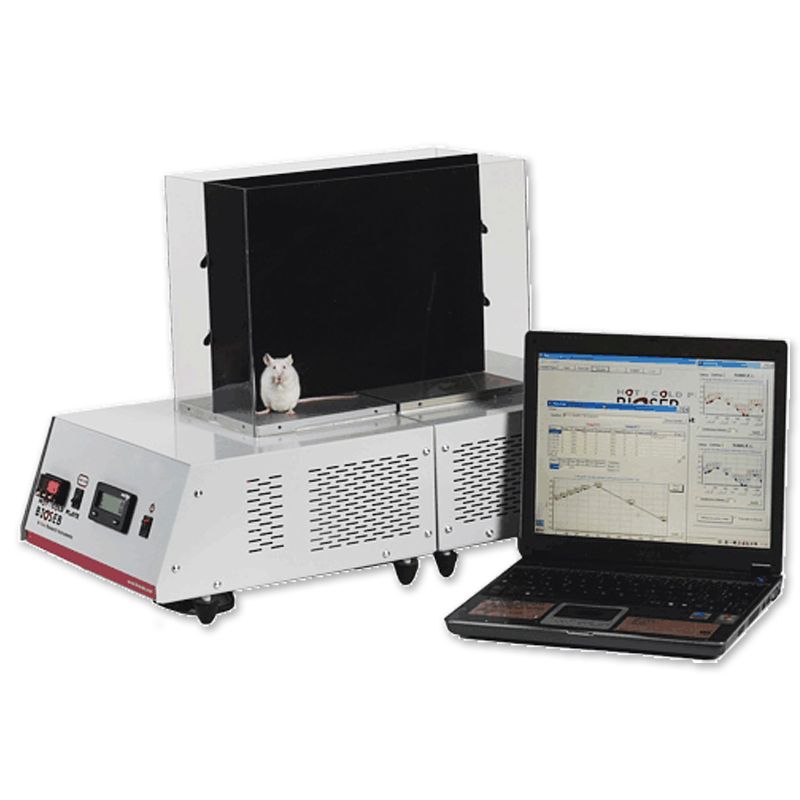Thermal Place Preference
Price on Request
For testing animal sensitivity to pain resulting from exposure to heat or cold.
- Easily monitor thermal place preference and nociceptive thresholds
- Unrestrained animals allows for maximum accuracy
- Automatic Detection Software eliminates the user subjectivity
This behavioral assay will allow monitoring of temperature preferences, nociceptive thresholds and investigate the role of a given gene or compound on these thresholds.
As advised by A. MOQRICH, and published in Moqrich et al (Science 2005, 307: 1468-72), the Thermal Place Preference Test allows researchers to work on unrestrained animals (mice and rats) let free to choose their preferred position (comfort zone) between 2 compartments set at different temperatures. This behavioural assay will allow monitoring temperature preferences, nociceptive thresholds and state in the role of a given gene or a compound on these pain thresholds associated to cold and hot stimulation.
Unlike the cold/hot plate test, it is investigator-independent: using the traditional plates, an operator can measure the reaction time of an animal (mouse or rat) exposed to a certain temperature. The "two Temperatures Choice Test" will return a nociceptive response without any action from the operator, and the obtained value is a temperature or a temperature range indicating the sensitivity of the animal (mouse or rat) resulting to the exposure to different stimulations (cold or heat)
You have the possibility to either observe one rat at a time or two mice simultaneously and independently, making the Thermal Place Preference system remarkably attractive for your analgesia research.
Presentation
The Thermal Place Preference Test, or 2 Temperatures Choice Nociception Test, is an operator independant test to study pain thresholds in rodents (mouse and rat) by assessing temperature preference (comfort zone) - a brand new tool opening new fields of investigation for your analgesia/nociception research.As advised by A. MOQRICH, and published in Moqrich et al (Science 2005, 307: 1468-72), the Thermal Place Preference Test allows researchers to work on unrestrained animals (mice and rats) let free to choose their preferred position (comfort zone) between 2 compartments set at different temperatures. This behavioural assay will allow monitoring temperature preferences, nociceptive thresholds and state in the role of a given gene or a compound on these pain thresholds associated to cold and hot stimulation.
Unlike the cold/hot plate test, it is investigator-independent: using the traditional plates, an operator can measure the reaction time of an animal (mouse or rat) exposed to a certain temperature. The "two Temperatures Choice Test" will return a nociceptive response without any action from the operator, and the obtained value is a temperature or a temperature range indicating the sensitivity of the animal (mouse or rat) resulting to the exposure to different stimulations (cold or heat)
You have the possibility to either observe one rat at a time or two mice simultaneously and independently, making the Thermal Place Preference system remarkably attractive for your analgesia research.
Dedicated software
The optional, dedicated T2CT software is a convenient tool allowing the operator to define the temperature of each zone, and easily, automatically obtain the position & presence time of each animal (mouse or rat). Results can be transferred directly as an Excel file or as a txt format. Software is compatible with Windows 7/8, in both 32 and 64 bits, and comes with 3 USB cables and a webcam.Parameters measured
- Time spent in each temperature zone (abs. and %)
- Time of each zone trespassing
- Temperature of each zone
- Activity time of the animal (total or by zone)
- Distance run by the animal (total or by zone)
- NEW algorithm for tracking activity and detecting zone transitions
- NEW single window for all settings
- NEW improved electronics are more stable and result in faster temperature transitions
Available set-ups
The system is available in 2 different set-ups:- The 76-0475 Thermal Place Preference set-up provides everything for the test (2 hot-cold plate units, camera/support and software) and is easily upgradable to the GRADIENT test by adding the 76-0775 Upgrade kit.
- The 76-0785 Thermal Place Preference set-up is a cost-saving set-up providing everything for the test (1 single unit with 2 plates, camera/support and software) but that cannot be upgradable to the GRADIENT test.
| Specifications | 76-0475 |
|---|---|
| Temperature Range | -3°C to +55°C (room temperature 20 to 25°C) |
| Temperature Accuracy | ± 0.5°C |
| Max Overshoot | 0.5°C |
| Power Supply | 150 Watts, 120/240 VAC |
| Dimensions | (L x W x H) 32 x 57 x 45.5 cm (12.6 x 22.4 x 17.9 in) including cage |
| Animal Cage | 330 x 165 x 300 mm (13 x 6.5 x 11.8 in) |
| Weight | 14 kG |
| Animal Cage | Material Clear plexiglass |
| Time and position measurement | 1s accuracy, video analysis |
| Software | Windows® 7/8 32/64 bits PC with 512 MO RAM with 3 USB ports |
Hache G, Guiard BP, Nguyen TH, Quesseveur G, Gardier AM, Peters D, Munro G, Coudoré F. (2015 ) Antinociceptive activity of the new triple reuptake inhibitor NS18283 in a mouse model of chemotherapy-induced neuropathic pain. Eur J Pain.

